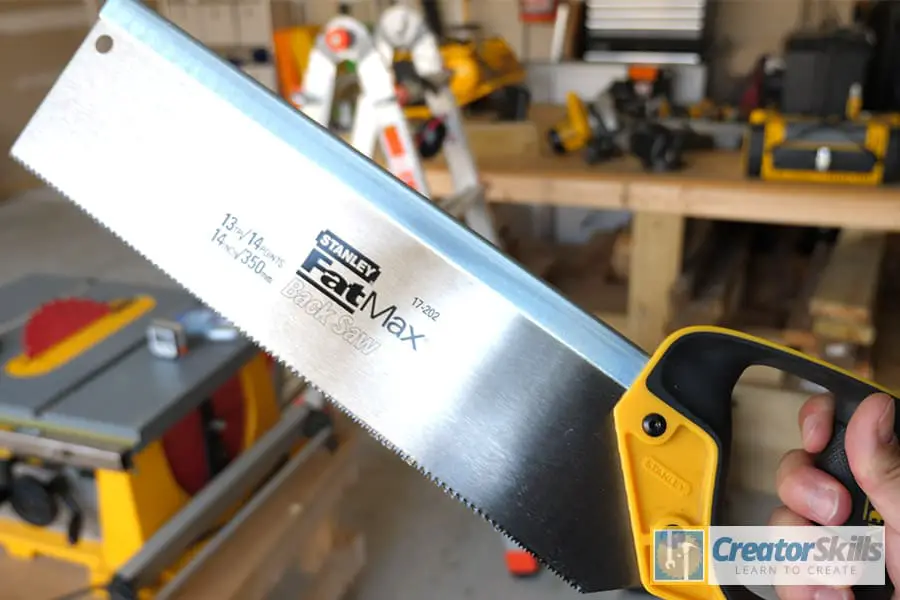
When I was using my tenon saw the other day, I thought about all of the times I used it. I wanted to share some information on tenon saws that I’ve learned through the years.
So, what is a tenon saw? A tenon saw is a type of back saw that is used to make straight cuts, usually for tenon joints in woodworking applications. Tenon saws cut pretty fast, and have a rib along the top edge of the blade, like a spine. The rib makes the blade very stiff, allowing it to cut more accurately.
A tenon saw can be used in a number of ways, and there are some tips that will help you below. Keep reading to quickly get up to speed on all-things tenon saw related.
What is a Tenon Saw
As I mentioned earlier, a tenon saw is in the back saw family because of the rib along it’s back. The rib helps make the saw very stiff and rigid. This helps the blade to not bend as you cut, which makes it a great saw for beginners. It is also easy to use, which is why it’s one of the more common saws.
I’d say that the only bad things about a tenon saw are that it has a limited cut depth and it’s powered by elbow grease.
What is a Tenon Saw Used For
A tenon saw is usually used to cut the tenon portion of a mortise and tenon joint. A simpler way of putting it is basically just removing some or all of the sides of a piece of wood so it can fit into a hole.
You can also use it for cutting the angled sections of a dovetail joint and miter joints. If you’re using a tenon saw for miters, then you should probably use a miter jig so that your cuts are perfect. I wouldn’t attempt miters without one.
Cross-cutting wood can also be done with a tenon saw, as long as the cut isn’t deeper than the saw can cut. They can be used for cutting both hardwood and softwood too. People who make a lot of furniture keep tenon saws close by because it is pretty handy.
A tenon saw is not used for cutting curves. I wouldn’t even try it. It’s absolutely terrible. It’s also not good at cutting through thick lumber. There are other saws that do much better at both of these things!
What is a Tenon Joint
A tenon joint is one half of a mortise and tenon joint. The tenon is considered the male side and is snugly fitted into the female side. The female side is called a mortise joint. Think of a square or rectangular peg going into a hole. It’s pretty simple.
Mortise and tenon joints are very popular in furniture because it’s an easy joint to create and it is very strong. The increased surface area between the mortise and tenon parts of the joint allows more glue to be used to create a stronger bond. It’s peg in a hole type solution also makes it more durable because the tenon can usually only go in and out in one direction.
Also, there are a ton of different types of mortise and tenon joints. Common types are called stopped (Or sometimes called blind), through, angled, and wedged. I could talk for hours about different joints and how they’re used, but that’s for another day!
What Does a Tenon Saw Look Like and Made Of
A tenon saw has a reasonably large metal blade that is bigger than a coping saw, but smaller than a standard cross-cut saw. Its blade is usually rectangular in shape, with cutting teeth on one of the longer sides and a rib or spine on the other. Like I mentioned above, the spine makes the blade much more stiff and rigid. The added strength makes the saw perform very well on straight cuts.
The blade of a tenon saw usually has around 10-16 TPI (Teeth Per Inch), and some models actually have a higher TPI towards the tip of the tenon saw. A common practice is to use a higher TPI tenon saw to start your cut and then switch to a lower TPI saw when you have your channel. Having 2 TPI’s on the same saw just speeds things up a little. Don’t worry if your saw isn’t this fancy.
A tenon saw’s handle is usually made of wood and is kind of pistol gripped. They can vary between manufacturers, and some people even make their own. Other tenon saws have either a rubber or plastic grips as well. The handle is fastened to the blade with pins, rivets, or metal bolts with screw heads.
How to Hold a Tenon Saw
Holding a tenon saw is kind of fun. You grip it like you’re shooting with your finger pointed forward down the side of the saw. The pointed finger method gives you a little more control over just gripping the handle with all of your fingers. It also feels much more normal to me.
Your other hand can do two other things, and it’s up to you and what you’re most comfortable with. The first option is to place it on the piece of wood that is being cut, but make sure it’s not where the blade is going to cut! This can help steady your workpiece if it’s not clamped.
The second option for your other hand is to place it along the spine of the saw, to either help guide it, or give a little more downforce. When I say a little, I mean a little. If you add too much, your wood could snap, or your blade could bind. Just be careful!
How to Use a Tenon Saw
Using a tenon saw is similar to other backsaws. Start by placing your saw on your cutline and pull it back one time. You want to repeat good, single direction strokes at the start to make sure your cut starts down the right path. Once you have a good cut going, you can start cutting in both directions.
A common cutting method is to keep the saw on and angle and cut down to your desired depth. Then start the opposite side angle on the other side of your cut, and also cut down to the desired depth. This will leave you with a triangle of wood in the center of your cut. Finish your cut by keeping your saw flat and removing the triangle.
Common Tenon Saw Problems and Fixes
- Saw Gets Stuck – This can happen if your workpiece is pinching the saw when cutting all the way through. Properly support your workpiece by making sure it isn’t “V-ing” as you progress through the cut. When the wood V’s, the blade kerf distance is reduced, which increases friction on the blade. The set could also be too low. Look at the teeth and determine if you need to increase the set distance.
- Leaves Rough Cut – If your tenon saw leaves too rough of cut for your liking, try switching to a saw with a higher TPI. The lower the TPI, the rougher the cut will be. It could also be because the teeth of the blade aren’t set evenly. Check your blade and bend the teeth needed to balance the set.
- Loose Handle – If your tenon saw’s handle gets loose, the easiest thing to do is tighten the screw side of the bolt. If your saw doesn’t have bolts with screw heads, then it probably has rivets. Try placing the saw over metal and hammer the rivets to try and get them tighter. You might need to replace them altogether.
- Won’t Cut All the Way Through – The rib or spine at the top of the tenon saw prevents it from cutting through thick pieces of wood. This is because the kerf distance is usually smaller than the width of the spine. If you are in the market for a tenon saw, make sure your desired saw has a cut depth that you’re ok with, so you can avoid this problem. If you do run into this problem, just use a different saw, like a bandsaw or different hand saw without a spine.
Tenon Saw Safety
A tenon saw has a sharp blade and should be used with the proper safety precautions. Below are some tips and tricks to keep you safe while using your tenon saw.
- Clamp Your Work – Your cut accuracy will improve, and your chances of cutting yourself will be reduced if you clamp your work while you’re using your tenon saw.
- Inspect Tenon Saw – Before using a tenon saw, check to see if you need to tighten the handle, or if it needs a little wax.
- Don’t Touch the Teeth of the Saw – If you never touch the teeth of the saw, then you should never get cut. It’s that simple!
- Use Safety Glasses – This is another no brainer, just like not touching the teeth of the saw. It would suck to lose vision, so it’s not with risking.
- Depth of Material – Since the blade of a tenon saw has a spine, it’s not designed to cut through really thick materials. Keep your cut less than the distance of the blade to the spine, and you’ll be in great shape.
- Wear Gloves – Some people wear gloves when using a saw and working with wood. This helps reduce the chance to cut yourself and get splinters.
Tenon Saw Conclusion
A tenon saw is an old school saw that is extremely solid. It’s strength and rigidity from the spine make it awesome for cutting really straight, and it’s even fun to hold!
Hopefully, I’ve helped you out in learning about tenon saws, but if you have any questions or comments, reach me in the section below!
